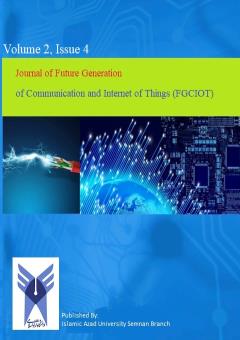Secure protocol for communications in IoT-based wireless sensor networks using kerberos and elliptic curve cryptography
محورهای موضوعی : Computer EngineeringMohammad ahmadinia 1 , Mohammad Davarpour 2
1 - Azad University, Kerman
2 - Department of Computer Engineering, Semnan Branch, Islamic Azad University, Semnan, Iran
کلید واژه: Internet of Things, Wireless Sensor Network, Security, Kerberos, Elliptic Curve,
چکیده مقاله :
The Internet of Things (IoT) is an emerging field of study and operation. IoT creates a structure for internet-connected devices. IoT-enabled systems are susceptible to various security and privacy attacks due to their inherently open nature. In IoT-enabled systems, multimedia information moves from one end to another, and computational complexity with constrained environments such as ad-hoc networks, mobile networks, etc., is crucial. Wireless Sensor Networks (WSNs) consist of a large number of sensor nodes, each with very limited computational power and storage capacity. Sensor nodes are typically installed for monitoring activities in unsupervised locations, controlled by one or more gateway nodes. Maintaining the confidentiality of information communication is one of the main challenges, and preserving the privacy of multimedia data from unauthorized access by attackers is a major issue for active WSNs with IoT. In this paper, to leverage the benefits of the Kerberos encryption protocol and reduce overhead for IoT-based wireless sensor networks, users are authenticated using the Kerberos protocol, and then sensor data is encrypted using elliptic curve encryption protocol. The proposed method enhances the security of wireless sensor network by combining Kerberos encryption and elliptic curve encryption techniques.
The Internet of Things (IoT) is an emerging field of study and operation. IoT creates a structure for internet-connected devices. IoT-enabled systems are susceptible to various security and privacy attacks due to their inherently open nature. In IoT-enabled systems, multimedia information moves from one end to another, and computational complexity with constrained environments such as ad-hoc networks, mobile networks, etc., is crucial. Wireless Sensor Networks (WSNs) consist of a large number of sensor nodes, each with very limited computational power and storage capacity. Sensor nodes are typically installed for monitoring activities in unsupervised locations, controlled by one or more gateway nodes. Maintaining the confidentiality of information communication is one of the main challenges, and preserving the privacy of multimedia data from unauthorized access by attackers is a major issue for active WSNs with IoT. In this paper, to leverage the benefits of the Kerberos encryption protocol and reduce overhead for IoT-based wireless sensor networks, users are authenticated using the Kerberos protocol, and then sensor data is encrypted using elliptic curve encryption protocol. The proposed method enhances the security of wireless sensor network by combining Kerberos encryption and elliptic curve encryption techniques.
[1] Conti, M., Dehghantanha, A., Franke, K., & Watson, S. (2018). Internet of Things security and forensics: Challenges and opportunities. Future Generation Computer Systems, 78(2), 544-546.
[2] Wang, S. C., Tseng, S. C., Wang, S. S., & Yan, K. Q. (2017, April). Reaching Safety Vehicular Ad Hoc Network of IoT. In Asian Conference on Intelligent Information and Database Systems (pp. 289-298). Springer, Cham.
[3] Heydari, N., & Minaei-Bidgoli, B. (2017). Reduce Energy Consumption and Send Secure Data Wireless Multimedia Sensor Networks Using A Combination of Techniques For Multi-Layer Watermark And Deep Learning. International Journal of Computer Science and Network Security (IJCSNS), 17(2), 98.
[4] Jaladi, A. R., Khithani, K., Pawar, P., Malvi, K., & Sahoo, G. (2017). Environmental Monitoring Using Wireless Sensor Networks (WSN) based on IOT. International Research Journal of Engineering and Technology (IRJET) 4(1), 1371-1378.
[5] Mishra, D., Vijayakumar, P., Sureshkumar, V., Amin, R., Islam, S. H., & Gope, P. (2017). Efficient authentication protocol for secure multimedia communications in IoT-enabled wireless sensor networks. Multimedia Tools and Applications, 1-31.
[6] Roux, J., Alata, E., Auriol, G., Nicomette, V., & Kaâniche, M. (2017, September). Toward an Intrusion Detection Approach for IoT based on Radio Communications Profiling. In 13th European Dependable Computing Conference, 88-96.
[7] Kaur, M., Singh, T. P., & Singh, B. (2015). Modification in the Kerberos Assisted Authentication in Mobile Ad-hoc Networks to Prevent Black Hole Attack. International Journal of Computer Applications, 117(23), 49-58.
[8] Yadav, D., Malwe, D., Rao, K. S., Kumari, P., Yadav, P., & Deshmukh, P. (2017). Intensify the security of One Time Password using Elliptic Curve Cryptography with Fingerprint for E-commerce Application. International Journal of Engineering Science, 8(3), 54-80.
[9] Lee, I., & Lee, K. (2015). The Internet of Things (IoT): Applications, investments, and challenges for enterprises. Business Horizons, 58(4), 431-440.
[10] Turkanović, M., Brumen, B., & Hölbl, M. (2014). A novel user authentication and key agreement scheme for heterogeneous ad hoc wireless sensor networks, based on the Internet of Things notion. Ad Hoc Networks, 20, 96-112.
[11] Amin, R., & Biswas, G. P. (2016). A secure light weight scheme for user authentication and key agreement in multi-gateway based wireless sensor networks. Ad Hoc Networks, 36, 58-80.
[12] Park, H. J. (2015). Enhanced User Authentication Scheme for Wireless Sensor Networks. International Journal of Security and Its Applications, 9(8), 367-374.
[13] Pan, W., Zheng, F., Zhao, Y., Zhu, W. T., & Jing, J. (2017). An Efficient Elliptic Curve Cryptography Signature Server With GPU Acceleration. IEEE Transactions on Information Forensics and Security, 12(1), 111-122.


